Digital Twin Market Size
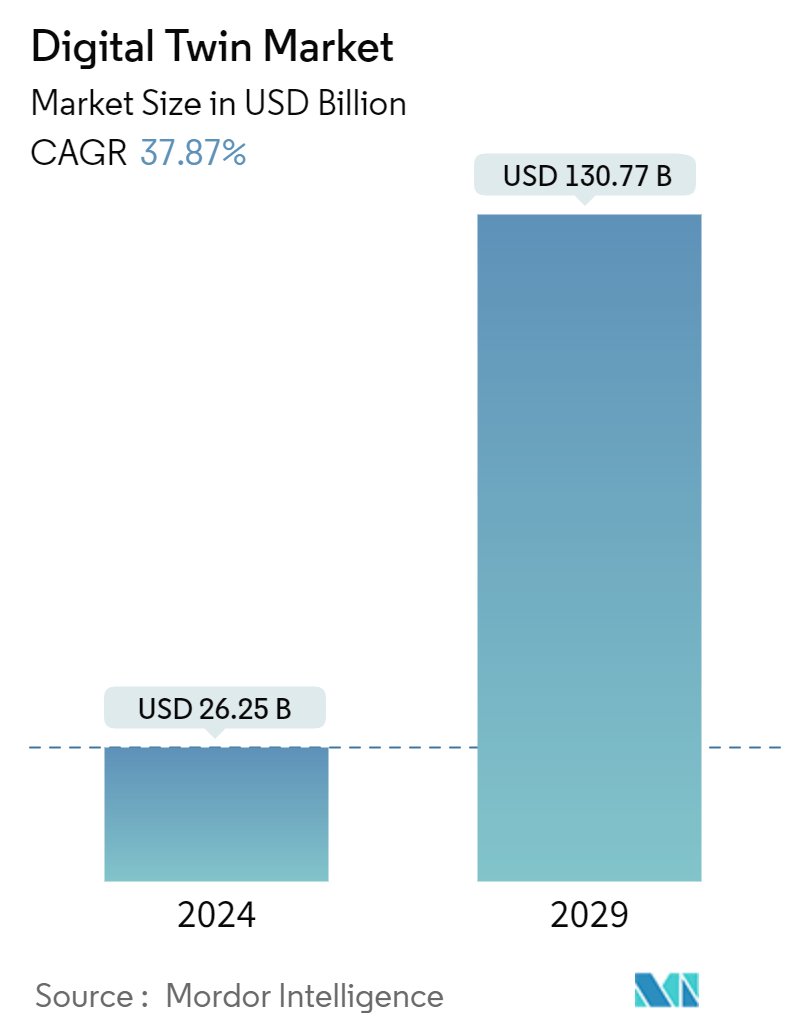
| Study Period | 2019 - 2029 |
| Market Size (2024) | USD 26.25 Billion |
| Market Size (2029) | USD 130.77 Billion |
| CAGR (2024 - 2029) | 37.87 % |
| Fastest Growing Market | Asia Pacific |
| Largest Market | North America |
Major Players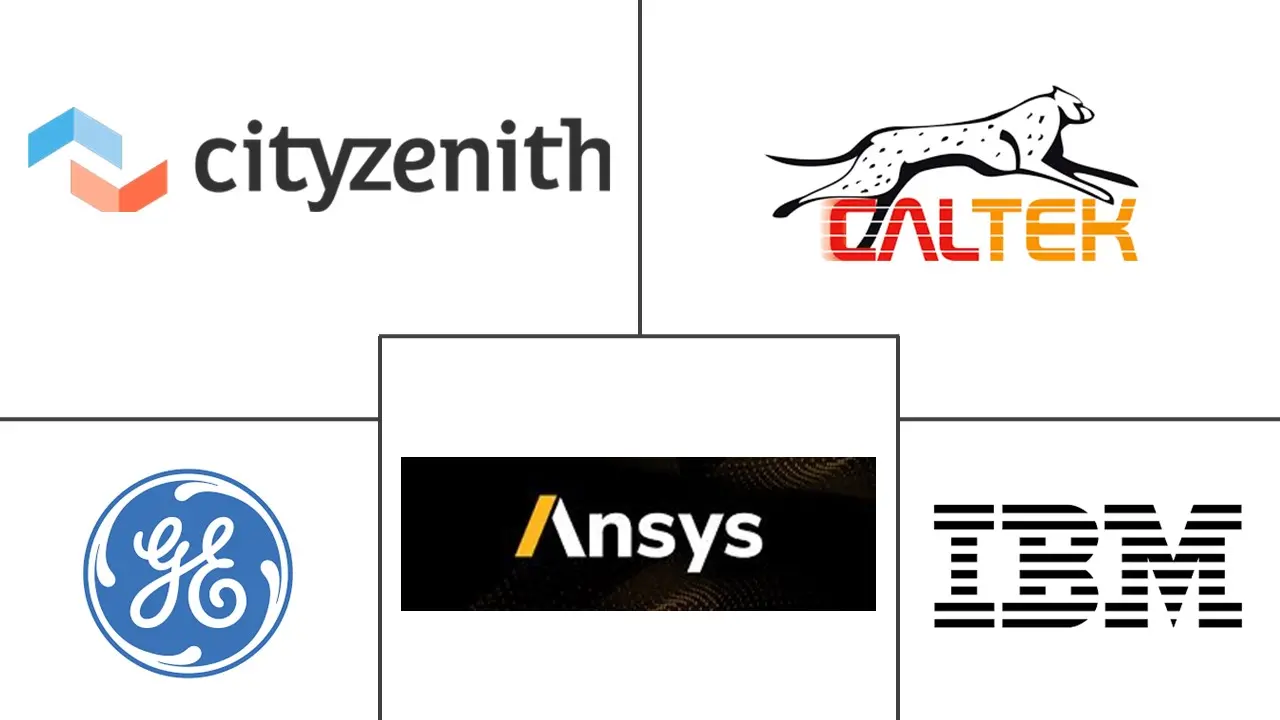
*Disclaimer: Major Players sorted in no particular order |
Digital Twin Market Analysis
The Digital Twin Market size is estimated at USD 26.25 billion in 2024, and is expected to reach USD 130.77 billion by 2029, growing at a CAGR of 37.87% during the forecast period (2024-2029).
- The adoption of digital twin technology witnessed significant growth due to the COVID-19 pandemic. Constrained by social distancing and travel limitations, businesses increasingly turned to digital twins for remote process monitoring and optimization. The healthcare sector also witnessed a sharp rise in the use of digital twins to simulate patient flows and enhance resource allocation in hospitals. This heightened interest in digital twins was not limited to healthcare. Factories also embraced the technology to manage production lines and ensure workers’ safety.
- Digital twins incorporate artificial intelligence (AI), Big Data, machine learning (ML), and the Internet of Things (IoT) in Industry 4.0 and are predominantly used in the industrial Internet of Things (IIoT), engineering, and manufacturing business space. The widespread usage of IoT has made digital twin technology more cost-effective and accessible for the business world.
- The growth in the use of digital twins is anticipated to transform the manufacturing processes and offer innovative approaches to reducing costs, optimizing maintenance, monitoring assets, reducing downtime, and creating new connected products. Although not new, the digital twin model has been entering manufacturing and other industries rapidly. Technologies such as IoT and cloud-based platforms have been major drivers for the increased adoption of digital twin solutions.
- The market’s growth is expected to be hampered by the presence of traditional systems used in underdeveloped countries. Most of these legacy systems had already been developed but were primarily designed and built to function without connectivity. They cannot incorporate advanced sensor technology that offers real-time data, limiting the adoption of advanced technologies.
- However, post-pandemic, companies are increasingly turning to digital twins to model and enhance their operational resilience. This proactive approach helps them craft robust response and recovery strategies, better preparing them for future market disruptions.
Digital Twin Market Trends
Manufacturing to be the Largest Application
- Digital twins are used throughout the life cycle of a product, ranging from design and development to production and after-sales service. This allows manufacturers to improve products and processes continuously based on real-time feedback. By forming digital replicas of machinery and equipment, manufacturers can predict potential failures and schedule maintenance before issues arise, minimizing downtime and extending the life of assets. Manufacturers can reduce the cost and time associated with assembling, installing, and validating factory production systems using digital twins replicating the product and production systems.
- The rapid spread of Internet of Things (IoT) devices and advancements in artificial intelligence (AI) enable more detailed and real-time data collection, crucial for creating accurate digital twins. According to GSMA, North America's total number of consumer and industrial IoT connections is forecast to grow to 5.4 billion by 2025.
- In addition, according to Ericsson, in 2023, the number of short-range IoT devices reached 12.39 billion worldwide. This number is forecast to increase to 25 billion by 2027. Such growing IoT technologies may develop the market for digital twins.
- As manufacturing complexity and demand for more advanced technology grows, it has become more difficult for companies to design, verify, and validate products of semiconductor chips. Digital twins enable faster and more complete IC verification and validation cycles, leading to significantly higher quality end-products and faster market time. For example, Siemens uses digital twins' technology for IC verification and validation.
- Furthermore, the manufacturing sector's growth may further propel the market's demand. According to the Dallas Fed, in February 2024, global industrial production, excluding the United States, increased by 1.1% compared to the same time in the previous year, based on three-month moving averages. Furthermore, according to the World Bank, in April 2024, the global PMI amounted to 50.5 for new export orders and 50.3 for manufacturing.
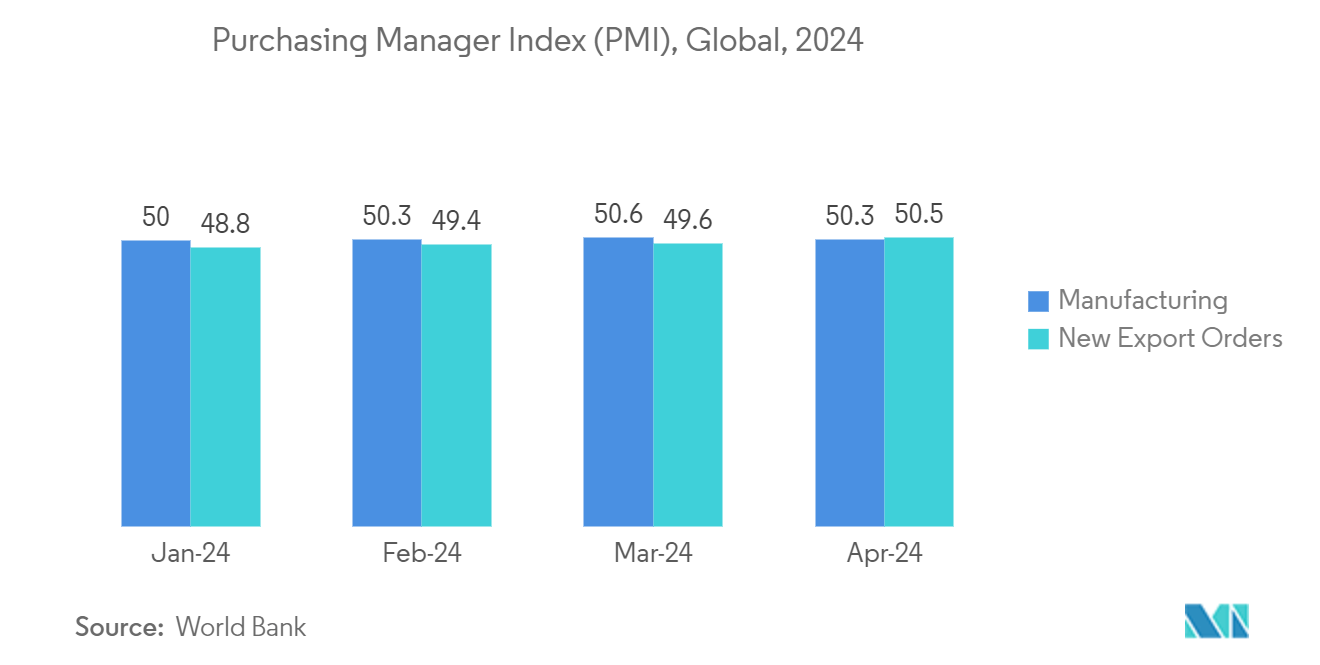
North America Holds Largest Market Share
- With the continuous integration of the digital realm into the physical world, digital twin technology has become a crucial tool for transforming industries and operations. Sectors such as manufacturing, aerospace, oil and gas, automobile, and others in the area effectively utilize the advantages of digital twin technology. The rise in adoption rates and the active involvement of vendors in the regional market are projected to propel the market's expansion.
- For instance, federal agencies in the United States have begun exploring the applications of digital twins, showcasing a significant embrace of this technology. Recent reports from Accenture reveal that various entities such as The Air Force, Navy, the Department of Energy, the Department of Agriculture, and the National Oceanic and Atmospheric Administration have introduced the development of digital twins or shown keen interest in doing so. These advancements indicate a growing recognition within the US government of the advantages that digital twins can offer.
- Moreover, the region's manufacturing sector is expected to drive the demand for digital twin technology at a significant rate. Digital twin technology allows manufacturers to develop virtual replicas of machine tools prior to their physical fabrication. This facilitates testing and prototyping in a digital setting, empowering engineers to identify and resolve potential issues before the start of real production. The increasing investments in the region's manufacturing sector and extensive production capabilities will enable the market to grow significantly during the forecast period.
- Canadian manufacturing, construction, and automotive sectors are witnessing a substantial adoption of digital twins. These industries leverage digital twin technology to assess the performance of their physical assets, pinpoint areas for enhancement, and ultimately achieve more favorable results. Furthermore, the healthcare sector in Canada is increasingly embracing digital twin technology, poised to propel the market's growth.
- Moreover, the nation presents substantial growth potential across multiple sectors and is poised to bolster its market share significantly in the coming years. With escalating investments in the aerospace and O&G industries, the market is set to capitalize on these opportunities. Furthermore, the growing attention on renewable energy sources within the power sector is primed to propel the market’s growth.
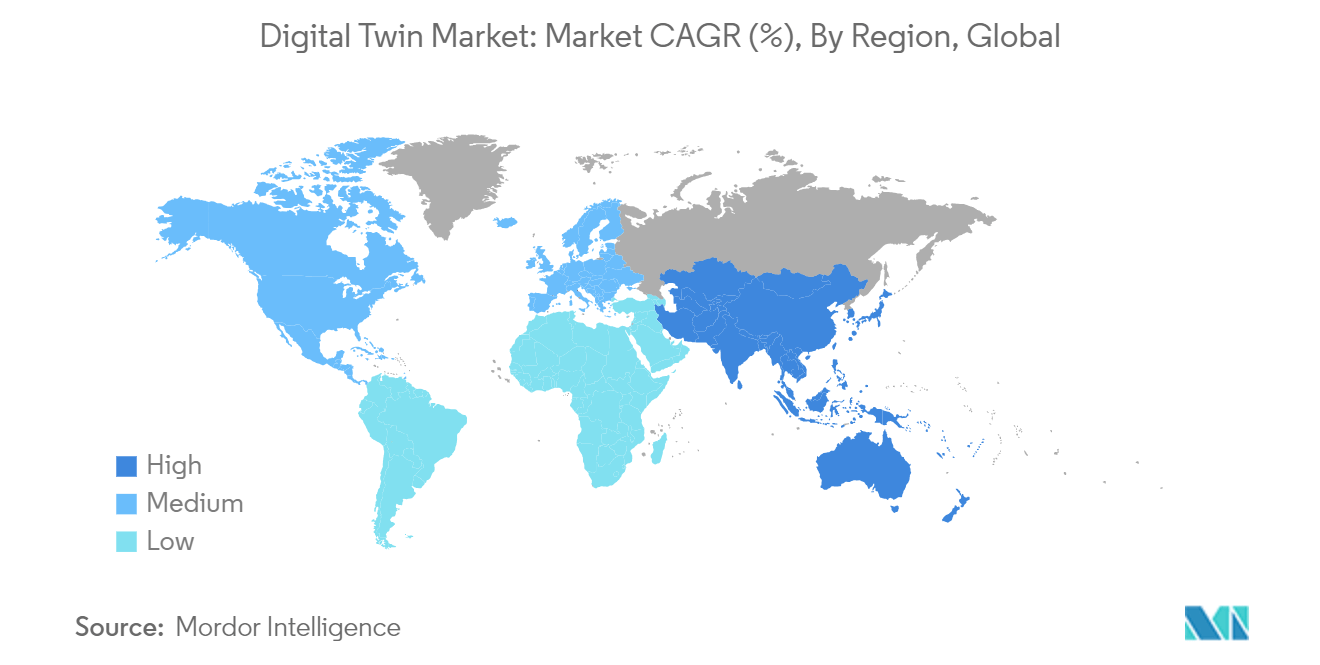
Digital Twin Industry Overview
The digital twin market is fragmented with major players like ANSYS Inc., Cal-Tek SRL, Cityzenith Inc., General Electric Company, and IBM Corporation. Players in the market are adopting strategies such as partnerships and acquisitions to enhance their service offerings and gain sustainable competitive advantage.
- March 2024: IBM Consulting, in collaboration with NVIDIA, spearheaded AI-driven transformations for its clients within an open ecosystem. This strategic alliance leverages IBM Consulting's profound industry insights and technological prowess, synergizing with NVIDIA's offerings, such as the NVIDIA AI Enterprise software. Noteworthy components include the introduction of NVIDIA NIM microservices and the versatile NVIDIA Omniverse platform. Central to their strategy are generative AI, robotics, and digital twins, pivotal for seamless integration into production environments. IBM Consulting is at the forefront, harnessing NVIDIA's Isaac Sim and Omniverse to craft and deploy digital twin applications. These applications are revolutionizing supply chain and manufacturing landscapes, orchestrating intricate multi-agent robotic setups.
- March 2024: Microsoft Corp. and NVIDIA expanded their longstanding collaboration with powerful new integrations that leverage the latest NVIDIA generative AI and Omniverse technologies across Microsoft Azure, Azure AI services, Microsoft Fabric, and Microsoft 365.
Digital Twin Market Leaders
-
ANSYS Inc.
-
Cal-Tek SRL
-
Cityzenith Inc.
-
General Electric Company
-
IBM Corporation
*Disclaimer: Major Players sorted in no particular order
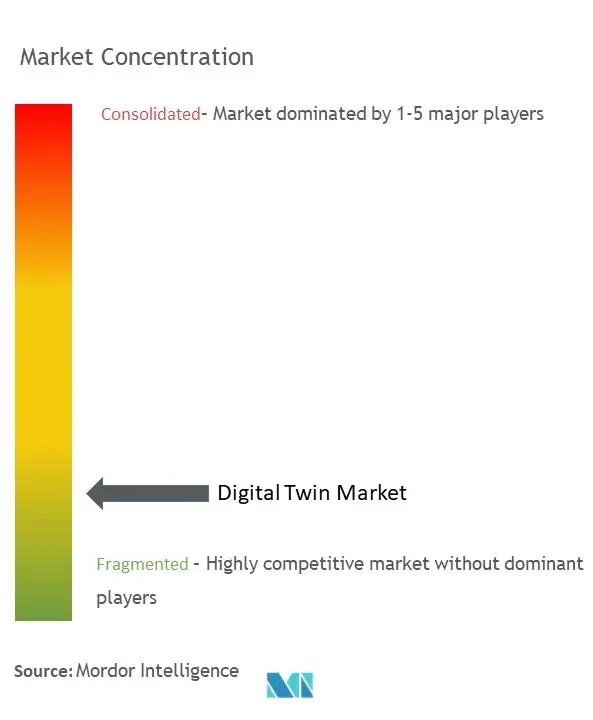
Digital Twin Market News
- June 2024: Siemens and KU Leuven collaborated to research digital twins for smart and sustainable products, promoting methodological research, stimulating innovations in industrial applications, disseminating results, and supporting educational activities within the field of digital twin technologies.
- April 2024: Matterport Inc., a key player in spatial data and a frontrunner in the digital transformation of the built environment, entered into an agreement with CoStar Group Inc., a provider of online real estate marketplaces, information, and analytics. CoStar will be acquiring Matterport in the deal, which values each share at USD 5.50. This translates to an equity valuation of around USD 2.1 billion and an enterprise value of approximately USD 1.6 billion, based on CoStar's closing stock price on April 19, 2024. The transaction is expected to increase the development and deployment of Matterport's advanced AI and digital twin technology.
Electrical Digital Twin Market Report - Table of Contents
1. INTRODUCTION
- 1.1 Study Assumptions and Market Definition
- 1.2 Scope of the Study
2. RESEARCH METHODOLOGY
3. EXECUTIVE SUMMARY
4. MARKET INSIGHTS
- 4.1 Market Overview
-
4.2 Industry Attractiveness - Porter's Five Forces Analysis
- 4.2.1 Bargaining Power of Suppliers
- 4.2.2 Bargaining Power of Consumers
- 4.2.3 Threat of New Entrants
- 4.2.4 Threat of Substitutes
- 4.2.5 Intensity of Competitive Rivalry
- 4.3 Industry Value Chain Analysis
- 4.4 Assessment of the Impact of COVID-19 on the Industry
5. MARKET DYNAMICS
-
5.1 Market Drivers
- 5.1.1 Growth in IoT and Cloud-based Platforms
- 5.1.2 Surge in Adoption of 3D Printing Technology in the Manufacturing Industry
- 5.1.3 Objective to Reduce Project Cost
-
5.2 Market Challenges
- 5.2.1 Inadequate Infrastructure in Under-developed Countries and Data Security-related Concerns
6. MARKET SEGMENTATION
-
6.1 By Application
- 6.1.1 Manufacturing
- 6.1.2 Energy and Power
- 6.1.3 Aerospace
- 6.1.4 Oil and Gas
- 6.1.5 Automobile
- 6.1.6 Others Applications
-
6.2 By Geography***
- 6.2.1 North America
- 6.2.1.1 United States
- 6.2.1.2 Canada
- 6.2.2 Europe
- 6.2.2.1 United Kingdom
- 6.2.2.2 Germany
- 6.2.2.3 France
- 6.2.3 Asia
- 6.2.3.1 China
- 6.2.3.2 Japan
- 6.2.3.3 India
- 6.2.4 Australia and New Zealand
- 6.2.5 Latin America
- 6.2.6 Middle East and Africa
7. COMPETITIVE LANDSCAPE
-
7.1 Company Profiles*
- 7.1.1 ANSYS Inc.
- 7.1.2 Cal-Tek SRL
- 7.1.3 Cityzenith Inc.
- 7.1.4 General Electric Company
- 7.1.5 IBM Corporation
- 7.1.6 Lanner Group Limited (Royal Haskoning DHV)
- 7.1.7 Mevea Ltd
- 7.1.8 Microsoft Corporation
- 7.1.9 Rescale Inc.
- 7.1.10 SAP SE
8. INVESTMENT ANALYSIS
9. FUTURE OF THE MARKET
** Subject To AvailablityDigital Twin Industry Segmentation
A digital twin is a virtual simulation that accurately replicates a physical object. The digital twin market has been defined based on the revenues generated from the software and services used in various applications such as oil and gas, manufacturing, automobile, aerospace, and other end users around the globe.
The digital twin market is segmented by application (manufacturing, energy and power, aerospace, oil and gas, automobile, and other applications) and geography (North America [United States, Canada], Europe [United Kingdom, Germany, France, and the Rest of Europe], Asia-Pacific [China, Japan, India, and the Rest of Asia-Pacific], and the Rest of the World). The market sizes and forecasts are provided in terms of value in USD for all the above segments.
| By Application | Manufacturing | |
| Energy and Power | ||
| Aerospace | ||
| Oil and Gas | ||
| Automobile | ||
| Others Applications | ||
| By Geography*** | North America | United States |
| Canada | ||
| By Geography*** | Europe | United Kingdom |
| Germany | ||
| France | ||
| By Geography*** | Asia | China |
| Japan | ||
| India | ||
| By Geography*** | Australia and New Zealand | |
| Latin America | ||
| Middle East and Africa |
Electrical Digital Twin Market Research FAQs
How big is the Digital Twin Market?
The Digital Twin Market size is expected to reach USD 26.25 billion in 2024 and grow at a CAGR of 37.87% to reach USD 130.77 billion by 2029.
What is the current Digital Twin Market size?
In 2024, the Digital Twin Market size is expected to reach USD 26.25 billion.
Who are the key players in Digital Twin Market?
ANSYS Inc., Cal-Tek SRL, Cityzenith Inc., General Electric Company and IBM Corporation are the major companies operating in the Digital Twin Market.
Which is the fastest growing region in Digital Twin Market?
Asia Pacific is estimated to grow at the highest CAGR over the forecast period (2024-2029).
Which region has the biggest share in Digital Twin Market?
In 2024, the North America accounts for the largest market share in Digital Twin Market.
What years does this Digital Twin Market cover, and what was the market size in 2023?
In 2023, the Digital Twin Market size was estimated at USD 16.31 billion. The report covers the Digital Twin Market historical market size for years: 2019, 2020, 2021, 2022 and 2023. The report also forecasts the Digital Twin Market size for years: 2024, 2025, 2026, 2027, 2028 and 2029.
What are the future trends in the Digital Twin Market?
The key future trends in the Digital Twin Market are: a) Integration of AI and machine learning for better predictive analytics b) Increased adoption in Small and Medium Enterprises (SMEs) c) Broader applications in sectors like healthcare and urban planning
What are the future trends in the Digital Twin Market?
The key future trends in the Digital Twin Market are: a) Integration of AI and machine learning for better predictive analytics b) Increased adoption in Small and Medium Enterprises (SMEs) c) Broader applications in sectors like healthcare and urban planning
Digital Twin Industry Report
The Digital Twin Market Report is segmented by application, including manufacturing, energy and power, aerospace, oil and gas, automobile, and other applications, and by geography, covering North America, Europe, Asia Pacific, and the rest of the world. The market sizes and forecasts are provided in terms of value for all the above segments. The digital twins market is witnessing remarkable growth, driven by the rising adoption of Internet of Things and cloud-based platforms across diverse industries. This innovative technology, which provides a virtual model of a physical object, system, or process, is celebrated for its ability to simulate, monitor, analyze, and optimize operations.
The digital twins market size is on an upward trajectory, finding applications in manufacturing, healthcare, automotive, energy, and aerospace sectors. It offers benefits like predictive maintenance, business optimization, and streamlined product development, despite data security and integration challenges. North America leads in adoption due to its technological prowess and digital transformation initiatives, while the Asia Pacific region is rapidly catching up, propelled by smart city and industrial modernization projects.
According to Mordor Intelligence™ Industry Reports, the digital twins market share and revenue are growing, with detailed analysis and forecasts available in their free report PDF download. This technology is set to revolutionize industry efficiency and innovation levels. The market growth is evident in the increasing market size and market value, reflecting the industry's trends and market segmentation. Industry analysis shows that market leaders are leveraging digital twins for market predictions and industry outlook. The market overview and market review highlight the importance of industry reports and industry research in understanding market data and market forecast.
The industry information and industry statistics indicate a positive growth rate, with market trends pointing towards a significant rise in industry size and industry sales. The market outlook and market overview provide insights into the future of digital twins, with market predictions suggesting continued expansion. Research companies are focusing on market segmentation to identify key areas for growth. The report example and report PDF offer comprehensive industry analysis, making it a valuable resource for understanding market trends and market value.



